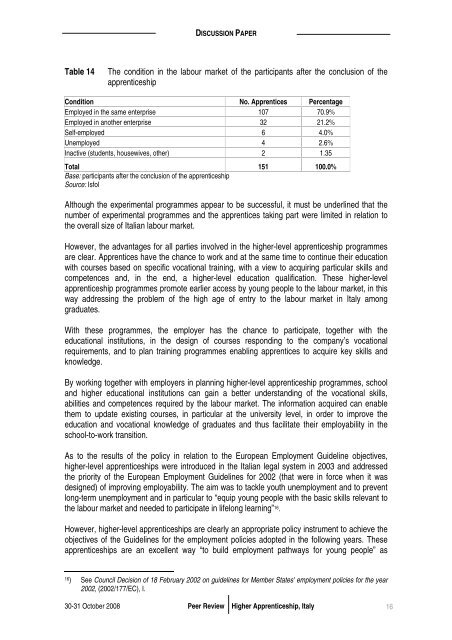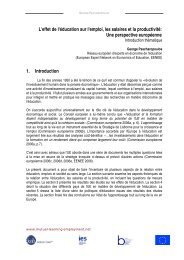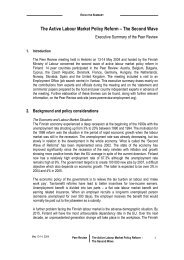Discussion Paper - Mutual Learning Programme
Discussion Paper - Mutual Learning Programme
Discussion Paper - Mutual Learning Programme
You also want an ePaper? Increase the reach of your titles
YUMPU automatically turns print PDFs into web optimized ePapers that Google loves.
DISCUSSION PAPER<br />
Table 14 The condition in the labour market of the participants after the conclusion of the<br />
apprenticeship<br />
Condition No. Apprentices Percentage<br />
Employed in the same enterprise 107 70.9%<br />
Employed in another enterprise 32 21.2%<br />
Self-employed 6 4.0%<br />
Unemployed 4 2.6%<br />
Inactive (students, housewives, other) 2 1.35<br />
Total 151 100.0%<br />
Base: participants after the conclusion of the apprenticeship<br />
Source: Isfol<br />
Although the experimental programmes appear to be successful, it must be underlined that the<br />
number of experimental programmes and the apprentices taking part were limited in relation to<br />
the overall size of Italian labour market.<br />
However, the advantages for all parties involved in the higher-level apprenticeship programmes<br />
are clear. Apprentices have the chance to work and at the same time to continue their education<br />
with courses based on specific vocational training, with a view to acquiring particular skills and<br />
competences and, in the end, a higher-level education qualification. These higher-level<br />
apprenticeship programmes promote earlier access by young people to the labour market, in this<br />
way addressing the problem of the high age of entry to the labour market in Italy among<br />
graduates.<br />
With these programmes, the employer has the chance to participate, together with the<br />
educational institutions, in the design of courses responding to the company’s vocational<br />
requirements, and to plan training programmes enabling apprentices to acquire key skills and<br />
knowledge.<br />
By working together with employers in planning higher-level apprenticeship programmes, school<br />
and higher educational institutions can gain a better understanding of the vocational skills,<br />
abilities and competences required by the labour market. The information acquired can enable<br />
them to update existing courses, in particular at the university level, in order to improve the<br />
education and vocational knowledge of graduates and thus facilitate their employability in the<br />
school-to-work transition.<br />
As to the results of the policy in relation to the European Employment Guideline objectives,<br />
higher-level apprenticeships were introduced in the Italian legal system in 2003 and addressed<br />
the priority of the European Employment Guidelines for 2002 (that were in force when it was<br />
designed) of improving employability. The aim was to tackle youth unemployment and to prevent<br />
long-term unemployment and in particular to “equip young people with the basic skills relevant to<br />
the labour market and needed to participate in lifelong learning” 16 .<br />
However, higher-level apprenticeships are clearly an appropriate policy instrument to achieve the<br />
objectives of the Guidelines for the employment policies adopted in the following years. These<br />
apprenticeships are an excellent way “to build employment pathways for young people” as<br />
16 ) See Council Decision of 18 February 2002 on guidelines for Member States' employment policies for the year<br />
2002, (2002/177/EC), I.<br />
30-31 October 2008 Peer Review Higher Apprenticeship, Italy<br />
16





